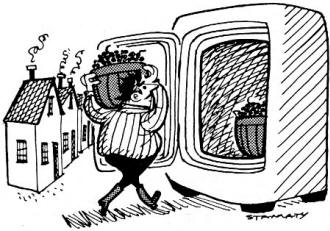Popular Electronics "Callithump"
|
|
Yes, I needed to look up the definition of "callithump." I have to admit to not really being sure why the title seemed apt to the editors. This is two separate mini-stories. The first, "A Dubious Tale," is a clever manipulation of a very familiar electronics / electrical mathematical law applied to a fictional town located on the shores of Scandinavia. The second, "A Day in a 1985 School," set in the mid-1960s, tells a futuristic tale - projected way forward into the 1980s - of a discussion between a father and his son regarding how things are going at school. Unlike similar predictions in the 1960s of a flying car in every garage and Dick Tracey watches on every wrist, this scenario has, although not exactly as envisioned, come to fruition. Popular Electronics "Callithump" Although history books are replete with accounts of the Spanish exploration of America, few books tell of a small colony that settled on the Scandinavian shores. This colony was called "El Ektrik." The Spanish had chosen a poor site and the only means of survival was to harvest and live off the currants that grew in the surrounding forests. But this was not easy, for Norsemen raiding parties forced the colonists to fight for their crops. The colonists needed a battery of vaults to protect their harvest. The currants were perishable, but the leader of the colonists, who had been schooled in England, had a good idea. "Let's store the 'arvest in our cool 'omes." And so they did, with such success that in a few years the leader began to worry about the inadequate vaultage and the unpredictable alternating currant production. Two brilliant El Ektricians, Al Gebra and Geo. Metry discovered that the vaultage required was proportional to the currant production and to the number of homes in the settlement. Thus, they convinced the leader of the colonists to pass a new law that enumerated the maximum number of homes per vault, or: vaultage = currant times 'omes Of course, you and I know that this law came down through the ages as 'omes law. - Errol J. Queen "Well, son," I said to my weary looking offspring, "it's a beautiful day, but you look like you had a rough one." "Yeah, pop, it was pretty miserable. Those moving sidewalks between classrooms are on the fritz and I had to walk all over the building. And, when I finally got to my advanced bio-physics class, I found that the computer center had sent over a substitute teacher. A real cornball with field-effect transistors and all that old junk. I didn't know they kept anything older than large-scale IC's on the premises." "I can see why you're tired," I commented in unfeigned understanding of his plight. "That was nothing. You should have seen what I was stuck with in my astrophysics calculus class." "What?" "My ILLIAC Mark XXXV had to go for maintenance and I did all of my logarithms on an analog computer. I'll bet even you had it easier back in the 60's." "We sure did," I answered, feeling a twinge of self-reproach. "The only things I remember breaking were pencil points. But, then, our math was so simple we always did it in our heads ... "By the way, son," I added, "how are your grades this quarter?" "Oh, they're okay. With my A-plus in muscular cytology and my B-minus in Babylonian cuneiforrns, I'm a cinch to pass the fourth grade." - Jerry Kruczek
Posted November 9, 2018 |
|


